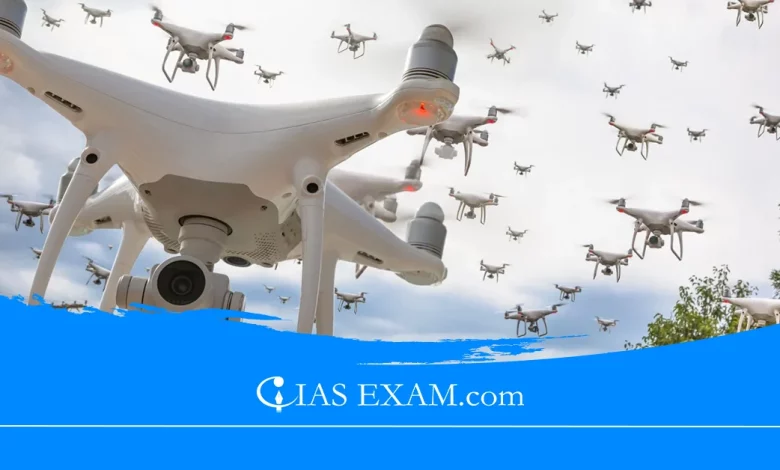
Context
Recently Iran’s Shahed-model drone, a Drone Swarm killed three U.S. service members in Jordan.
About
- Abbreviation: SWARM stands for “Smart War-Fighting Array of Reconfigured Modules”.
- Working of Multiple Drones: These models include multiple drones operating together in a coordinated manner to obtain various targets.
Features of Drone Swarms
- Scalability: Drone swarms can range in size, starting from just a few drones to masses or maybe hundreds of devices.
- Autonomy: Drone swarms are designed to function autonomously, without direct human control.
- Redundancy: In a swarm, individual drones can compensate for the loss or failure of others.
- Self Organizing Behaviour: These show collective self organizing (SO) behaviour through interaction and cohesion between robots, in addition to interaction of robots with the environment.
- Capabilities: There is no true leader and follower, with all agents in a swarm having their very own ‘thoughts’ able to undertake collective choice-making, adaptive formation flying, and self-healing.
- No Human Intervention: An armed, fully autonomous drone swarm (AFADS) with distributed AI will locate, identify, and assault objectives without human intervention.
Technology Behind Swarm Drones
- Swarm Control and Communication
-
-
- Swarm Algorithms: These are required to control the behaviour of individual drones in a swarm and make sure coordination.
- Protocols of Communication: Effective communication is essential. Drones can communicate either directly or through a central system, together with a ground station or a leader drone.
- Decentralized Control: Swarm drones frequently employ decentralised selection-making methods to enhance adaptability and robustness.
-
- Sensing and notion:
-
- Sensors: Drones are equipped with quite a few sensors (such as cameras, LiDAR, and GPS) for navigation, impediment recognition, and situation awareness.
- Computer Vision: It Allows drones to recognise and track objects, people, and terrain features, which helps in navigation and mission execution.
- Machine Learning and Artificial Intelligence: Algorithms permit drones to study, adapt, and make autonomous choices based totally on input records.
Swarm Formation and Coordination
- Formation Flying: Algorithms allow drones to hold precise formations for a variety of aims, inclusive of increasing insurance or decreasing susceptibility.
- Collaborative Tasks: Drones can work collectively to complete tasks like mapping a place, delivering payloads, and performing surveillance.
Advantages of Swarm Drones
- All Weather Operations: The Swarm Drone System is capable of being utilized in inclement climate and at high altitudes.
- Robot Soldiers: The drone swarm technology concept could also be used on land to create a force of robot-soldiers for land warfare, or mini-submarine swarms to tackle sea-surface or submarine threats.
- Speed and Agility: Drones own great velocity and agility for navy operations, as they are able to attain speeds of up to 100 km/h thanks to their sophisticated motors.
- Used in Different Missions: Drones can be used for quite a few offensive and protecting missions through the armed services. They may be used to release attacks towards terror launch sites, ammunition garage centers, tanks, and infantry fight motors.
- ATR functionality: Artificial intelligence powers swarm drones that could discover goals robotically due to their Automatic Target Recognition (ATR) capability. Tanks, weapons, automobiles, and people can all be acknowledged by ATR
Drone structures in Indian Military
- Swarm Drones: The Indian Army inducted swarm drones, which refer to several UAVs operating in coordination. These are useful in combat operations for surveillance inputs and undertaking reconnaissance.
- Indian Air Force has been pioneering swarm drone research and development with its Meher Baba initiative in view of 2019. This is geared in the depth of humanitarian assistance and disaster relief (HADR) operations.
- Switch VTOL (Vertical Take-Off and Landing) UAVs: VTOL capabilities make these beneficial in far off and difficult terrains.
- In 2021, Army signed a settlement with Mumbai primarily based ideaForge for those drones
- Few examples of Indigenous Drones: Lakshya, Nishant, TAPAS UAV (Rustom), etc.
- Acquisition of foreign drones: India has imported drone technology from diverse nations like the US and Israel.
- Heron Mark-ll drones: A Medium Altitude Long Endurance (MALE) UV, inducted by Indian Air Force to carry out surveillance alongside Northern borders with Pakistan and China.
- Searcher Mk Il drones: Developed by Israel Aerospace Industries, it’s beyond reconnaissance drone utilized by army and navy.
Drone policies in India
- National Counter Rogue Drone Guidelines: In 2019, the Ministry of Civil Aviation launched the report to put out suggestions assessing drone threat.
- Drone Rules 2021: It divides the Indian airspace into 3 zones Green, Yellow and Red based on acceptability of flying drones.
- Red zones aren’t any cross zones wherein no drones can be operated except for a permission given by the Central Government.
Source: The Live Mint
UPSC Mains Practice Question
Q.The use of unmanned aerial vehicles (UAVs) by our adversaries across the borders to ferry arms/ammunitions, drugs, etc., is a serious threat to the internal security. Comment on the measures being taken to tackle this threat. (2023)





.png)



